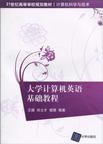大学计算机英语基础教程
出版时间:2010-9 出版社:清华大学出版社 作者:王振,刘士才,杨慧 编著 页数:217
前言
本书是一本用英语教授计算机基础知识的教材。全书内容丰富,分为八章,主要内容包括计算机基础知识、微型计算机计算机硬件组成、操作系统原理、Windows XP使用、Office 2007办公软件、计算机病毒、网络基础、 Internet和多媒体技术等内容。文字叙述简练、清楚,英语语言规范、流畅,较全面的覆盖了计算机科学和信息技术领域中基础层面的名词和术语,尤其是一些目前十分流行及最新的概念和词汇。书中含有大量丰富的图示,使书中描述的各种概念、术语和技术一目了然。所以,本书在使学生了解和掌握计算机及信息技术专业基础知识的同时,也有助于他们掌握相应的英语词汇,提高专业英语的阅读能力。由于欧美国家的课程和教学体系同中国有很大差异,特别是在基础教育部分,同类英文原版教材内容与我国的教学大纲相差较大,并且与其他后续课程的衔接也不够紧密;此外,原版教材内容多涉及文化背景,知识点叙述过于冗长,使得英语的学习时间远远超出理论知识本身的学习,对教学安排造成很大的压力。本书有效地克服了以上缺点。为方便读者学习,书中每小节后附有词汇表,每章后面均附有一定数量的习题。本书第1~6章由王振编写,第7、8章由杨慧编写,刘士才对全书内容结构做了规划与设计工作,并对部分章节进行了审核。本书既可以作为高等院校“大学计算机基础”课程的双语教材和相关专业的“计算机英语”课程教材,同时也可以作为一本自学计算机英语的参考书。由于我们水平有限,书中难免存在许多不足之处,恳请读者批评指正。
内容概要
编者基于多年的双语教学经验、良好的英语和计算机基础,参考目前“大学计算机基础”和“计算机专业英语”课程的教学大纲内容,编写了这样一部便于老师教学安排和学生学习的英文版教材(其中约2/3内容为英文,1/3为中文),使得选修双语课程和计算机专业英语的学生能在计算机和英语两个方面切实达到教学目的。 本书既可以作为高等院校“大学计算机基础”课程的双语教材和相关专业的“计算机专业英语”课程教材,同时也可以作为一本自学计算机英语的资料。
书籍目录
Chapter 1 Computer Basics 1.1 Development of Computer 1.1.1 History of Computer 1.1.2 Types of Computers Vocabulary 1.2 Basic Computer Components Vocabulary 1.3 Binary Numeral System 1.3.1 Conversion to and from Other Numeral Systems 1.3.2 Binary Arithmetic 1.3.3 Binary Logic Vocabulary 1.4 Signed Binary Numbers 1.4.1 Signed Magnitude 1.4.2 One's Complement 1.4.3 Two's Complement 1.4.4 Character 1.4.5 Other Data Representations Vocabulary 1.5 中文补充资料 1.5.1 逻辑设计基础 1.5.2 数字集成电路 1.5.3 中文字符编码 1.5.4 未来的新型计算机 REVIEW QUESTIONSChapter 2 Computer System 2.1 Hardware 2.1.1 Motherboard 2.1.2 CPU 2.1.3 Memory 2.1.4 Storage Devices 2.1.5 Bus 2.1.6 Ports and Peripherals 2.1.7 Input and Output Devices Vocabulary 2.2 Software 2.2.1 System Software 2.2.2 Application Software 2.2.3 Software Copyrights Vocabulary REVIEW QUESTIONSChapter 3 Operating System 3.1 What is an Operating System Vocabulary 3.2 Types of Operating Systems 3.3 Operating System Functions 3.3.1 Processor Management 3.3.2 Process Control Block 3.3.3 Memory Management 3.3.4 Device Management 3.3.5 Application Program Interfaces 3.3.6 User Interface Vocabulary 3.4 Windows XP 3.4.1 Basic Features of Graphical Interface 3.4.2 Windows XP Interface 3.4.3 File Management 3.4.4 Windows Explorer 3.4.5 Control Panel 3.4.6 The Most Popular Operating Systems 3.5 中文补充资料 3.5.1 关于进程管理 3.5.2 关于存储器管理 Vocabulary REVIEW QUESTIONSChapter 4 Word 2007 4.1 Introduction to Word 2007 4.1.1 Word Environment 4.1.2 Creating a New Blank Document 4.1.3 Zooming View In and Out 4.1.4 Inserting Text 4.1.5 Saving a Document Vocabulary 4.2 Editing a Document 4.2.1 Selecting Text 4.2.2 Cutting, Copying and Pasting 4.2.3 Undo and Redo 4.2.4 Find and Replace 4.2.5 AutoCorrect 4.2.6 Checking the Spelling and Grammar 4.2.7 Using the Thesaurus Vocabulary 4.3 Formatting Document 4.3.1 Formatting Text 4.3.2 Formatting Paragraph 4.3.3 Apply Bullets and Numbers 4.3.4 Formatting Text into Columns 4.3.5 Borders and Shading Vocabulary 4.4 Graphics 4.4.1 Using Graphics 4.4.2 Modifying Pictures Vocabulary 4.5 Tables 4.6 Editing Long Documents 4.6.1 Style 4.6.2 Table of Contents 4.6.3 Headers and Footers 4.6.4 Template 4.6.5 Adding Footnotes and Endnotes to a Document 4.6.6 Adding Captions 4.6.7 Creating Cross-References Vocabulary 4.7 Print 4.7.1 Previewing Documents 4.7.2 Printing the Document Vocabulary REVIEW QUESTIONSChapter 5 Excel 2007 5.1 Introduction to Excel 2007 5.1.1 Excel Environment 5.1.2 Creating and Saving Workbooks 5.2 Working with Workbooks 5.2.1 Understanding Workbooks and Worksheets 5.2.2 Working with Worksheets 5.2.3 Working with Cells 5.3 Spreadsheet Data 5.3.1 Entering Data 5.3.2 Formatting and Customizing Data 5.3.3 Formulas and Functions 5.4 Sorting and Querying Data 5.4.1 Sorting a Cell Range 5.4.2 Filtering Data with AutoFilter 5.4.3 Conditional Formatting 5.4.4 Calculating Subtotals 5.5 Charts 5.6 Using Page Setup Vocabulary REVIEW QUESTIONSChapter 6 PowerPoint 2007 6.1 Instruction to PowerPoint 2007 6.1.1 Creating a Presentation 6.1.2 Inserting Illustrations 6.2 Slide Effects 6.3 Others Vocabulary REVIEW QUESTIONSChapter 7 Network Technology 7.1 Background Vocabulary 7.2 Network Basics 7.2.1 Network Functions 7.2.2 Network Classifications 7.2.3 Physical Topology 7.2.4 Network Communications and Architecture 7.2.5 Basic Hardware Components 7.2.6 Network Links Vocabulary 7.3 Local Area Networks 7.3.1 LAN Standards 7.3.2 Installing a LAN 7.4 Internet Technology 7.4.1 Internet Basics 7.4.2 Internet Access 7.4.3 Internet Resources Vocabulary 7.5 Computer Virus Basics 7.5.1 Viruses, Trojan Horses, and Worms 7.5.2 Combating Viruses, Worms and Trojan Horses Vocabulary REVIEW QUESTIONSChapter 8 Digital Media 8.1 Digital Audio 8.1.1 Digitizing Audio 8.1.2 File Formats 8.2 Bitmap 8.2.1 Bitmap and Digitization 8.2.2 Bitmap Graphics Formats 8.3 Vector Graphics 8.4 Digital Video 8.4.1 Video Digitization and Transfer 8.4.2 Digital Video File Formats 8.5 Data Compression 8.5.1 Lossy and Lossless Compression 8.5.2 International Compression Standards VocabularyREVIEW QUESTIONS参考文献
章节摘录
插图:1. First Generation (1940—1956)The first generation computers used vacuum tubes for circuitry and magnetic drums for memory, and were often enormous, taking up entire rooms (see figure 1.1). They were very expensive to operate and in addition to using a great deal of electricity, generated a lot of heat, which was often the cause of malfunctions. First generation computers relied on machine language, the lowest-level programming language understood by computers, to perform operations, and they could only solve one problem at a time. Input was based on punched cards and paper tape, and output was displayed on printouts.2. Second Generation (1956—1963)By 1948, the invention of the transistor greatly changed the computer’s development (see figure1.2). The transistor replaced the large, cumbersome vacuum tube in televisions, radios and computers. As a result, the size of electronic machinery has been shrinking ever since. The transistor was at work in the computer by 1956. Coupled with early advances in magnetic-core memory, transistors led to second generation computers that were smaller, faster, more reliable and more energy-efficient than their predecessors.
编辑推荐
《大学计算机英语基础教程》:教学目标明确,注重理论与实践的结合;教学方法灵活,培养学生自主学习的能力;教学内容先进,反映了计算机学科的最新发展;教学模式完善,提供配套的教学资源解决方案。
图书封面
评论、评分、阅读与下载
用户评论 (总计3条)
- 快递态度差 我很不爽
- 物流速度挺快,书的质量也不错挺好,支持亚马逊
- 不错不错,是需要的东西,快速解决了我上课木有教材的难题~~这本书的主编王振就是我的计算机课老师哦~~
相关图书
- 计算机导论
- 信息技术应用基础
- Photoshop平面设计与制作
- 嵌入式软件测试实用技术
- jQuery JavaScript与CSS开发入门经典
- 高级英语视听说教程教师用书
- 大众菜谱3(VCD)
- 哑铃健身操(下)(VCD)
- 广州•国际汽车展(VCD)
- 共和国军队重大军事演习实录(VCD)
- 完全结婚手册2(VCD)
- 最美武夷山(DVD)
- 送礼好点子1(VCD)
- 女子缠足三寸金莲(VCD)
- 最优化技术与数学建模
- 大学物理学(下册)
- 高等代数(下册)
- 矩阵理论学习指导
- 罗家英:少林学武(下)(VCD)
- 调理健身操1(VCD)
- 世界名枪大典8专用枪(VCD)
- 西方检察制度史研究
- 司法预救济与再救济
- 2002-2003赛季CBA总决赛2(VCD)
- 小浣熊进城(卡通教育VCD+福光开心书卡+妈妈手册)
